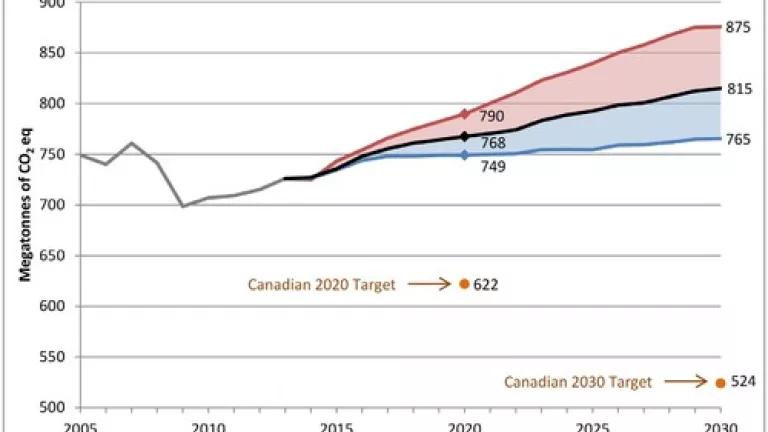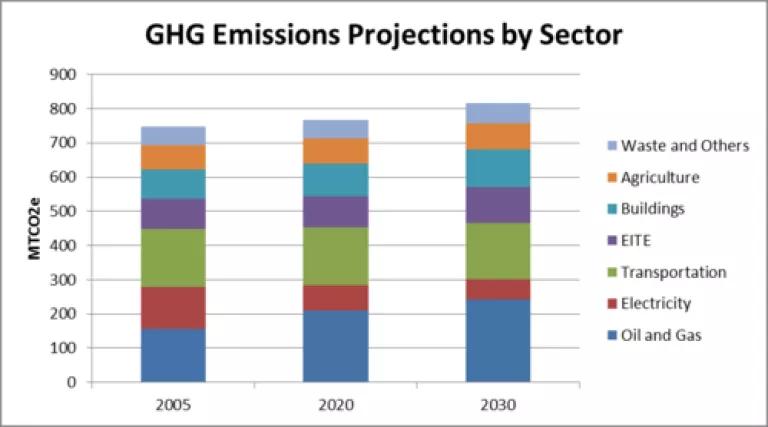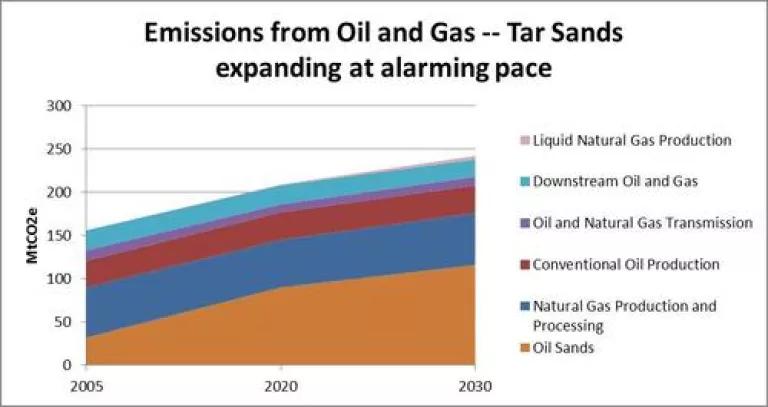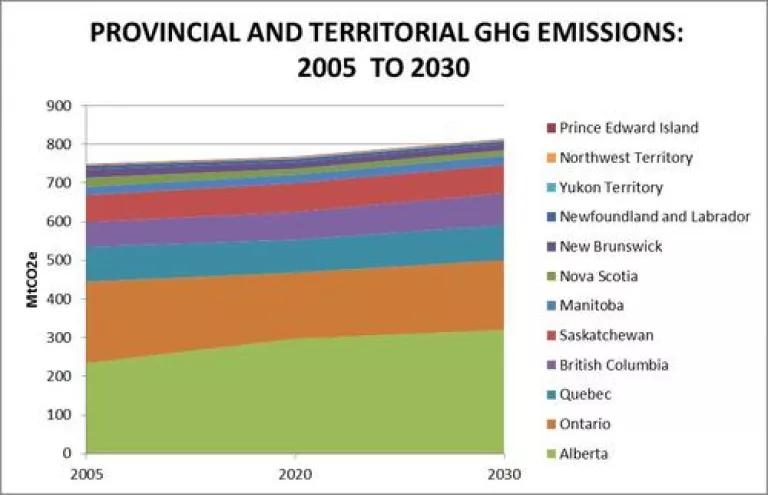
Earlier this month, Canada released its Second Biennial Report on Climate Change. This submission to the UN Framework Convention on Climate Change details trends in Canada's greenhouse gas emissions and projections for meeting climate commitments for 2020 and 2030. Canada's plans under the previous government were already considered less than ambitious, and we gave its 2030 target a failing grade. Unfortunately, the newly published forecasts for emissions growth - which are based on current government policies up to September 2015 - show that Canada won't even be able to meet those targets. Emissions are projected to increase; despite the fact that Canada's commitments indicate that significant annual cuts are required. The federal government has kicked off consultation with provinces on the pan-Canadian framework for climate change and has signed an MOU with the US and Mexico on climate change and clean energy, but it is clear more needs to be done.
With Canada's Biennial Report in mind, it is worth looking at: (1) whether Canada is on track for its climate targets; (2) whether it has a plan to meet the target; and (3) what are the key measures that need to be implemented in the coming years to meet the target (i.e., what observers should be tracking to see if Canada is serious about its climate targets).
Canada is poised to miss 2020, 2030 and 2050 targets
Canada is projected to significantly miss its 2020 and 2030 climate target with the set of measures it currently has in place (see figure). While no country has all the policies in place to meet their 2030 targets, Canada has a huge hole to dig out of if it is going to meet its 2020 target and be in a position to meet the 2030 target that is part of the Paris Agreement. As one of the world's top ten emitters, Canada's emissions reductions pathway is important for shifting the world to a low-carbon pathway that avoids the most serious impacts of climate change.
CANADA'S EMISSION PROJECTIONS- Significant gaps between projections and Canada's Climate Targets for 2020 and 2030
Source: Government of Canada, Second Biennial Report on Climate Change.*
Given the significant gap between future emissions and the goals for 2020 and 2030, it is clear that Canada is way off-track to a 80 percent cut by 2050. G7 leaders including former Prime Minster Stephen Harper committed to this in 2009.
What is the plan to get on track to climate targets?
There are some provincial and federal initiatives that are expected to help reduce emissions, but the report doesn't outline a set of measures to put Canada on track for its 2020 and 2030 targets. Emissions reductions efforts in some sectors have been successful: From 2005 to 2013, emissions from coal-fired electricity have fallen 33 MtCO2e, significantly cutting Canada's emissions in the electricity sector, with further reductions planned for 2020 and 2030. In transportation, emissions have remained relatively flat. Future growth in freight transport emissions are expected to be offset by lower passenger transport emissions.
More widespread adoption and implementation of new initiatives will be vital for meeting its target. Unfortunately the report didn't outline the exact measures the government envisions will be needed to meet its targets. Other countries' biennial reports include a "with measures" scenario to reflect the kinds of measures that they will need to implement to meet their target, but the Canadian report doesn't include such a scenario.
Key Actions that Canada will need to take to meet its target
Given that Canada is still far off track from meeting its climate targets, the new Trudeau Administration and provincial governments will need to make significant policy changes to reduce emissions in both the short and long term. The government has already committed to working with provinces and territories to develop a pan-Canadian framework to address climate change. If Canada is serious about meeting its climate targets it will need to put in place a series of new measures in its oil and gas sector (which is dominated by Alberta's tar sands) and transportation sector - as these are its two biggest emissions sources (see Figure),. It must promote a clean energy economy through more renewable energy and energy-efficiency efforts. It will be critical to see whether Canada announces additional measures along these lines in the coming months.

Source: Data from Government of Canada, Second Biennial Report on Climate Change
Addressing tar sands emissions is key to meeting climate target
While the biennial report lists many measures to reduce emissions, including a mix of provincial-level policies, there is a failure to adequately address the largest source of growing emissions - tar sands. The biennial report confirms that not enough is being done to tackle this source of pollution (see Figure).

Source: Data from Government of Canada, Second Biennial Report on Climate Change
This tar sands emissions dominance is most evident when you look at the projections of provincial level emissions growth. The Province of Alberta is projected to account for 63 MtCO2e of the national emissions increase from 2005 to 2020 due to tar sands production, with most other provinces reducing their emissions and a few growing emissions in the single digits. By 2030, Alberta's emissions will have grown 86 MtCO2e, while other provinces account for an aggregate reduction in emissions of 20 MtCO2e (see figure).

Source: Data from Government of Canada, Second Biennial Report on Climate Change
Alberta began making strides to address tar sands and other emissions under the leadership of its new Premier when it announced a new climate plan in late November 2015. As the director of NRDC's Canada project noted at the time:
"The Climate Leadership Plan, which imposes limits on emissions from tar sands production, accelerates the transition from coal to clean energy, and establishes an economy-wide tax on carbon pollution, is a strong step forward for Alberta on climate and sets the stage for Canada to move forward with bold climate action in Paris."
Alberta's Climate Leadership Plan is a significant step forward to constrain emissions increases in the province after 2020. Because Alberta's climate policy was announced after the deadline for inclusion in the Biennial Report, its impact on Canada's efforts to meet its 2020 and 2030 targets has yet to be seen. Alberta has shown leadership by taking efforts to rein in their province's growing emissions. However, further measures will be needed in order to support absolute emissions reductions in the province if Canada is to reach its climate targets. Certainly, the government cannot continue to actively facilitate tar sands expansion if it wants to meet its climate targets.
Canada needs to implement a stronger national level climate action plan.
At present, there are many separate regional initiatives taking place but such initiatives are not a substitute for strong federal policies on climate. The newly elected federal government will need to work hard to fulfill its climate commitments - especially by implementing a true pan-Canadian framework for climate and collaborating with other countries. Last week's Vancouver Declaration on Clean Growth and Climate Change is only a start, and many details need to be hammered out with the provinces in the months ahead. All of Canada's provinces and territories already declared before the Paris Climate Conference that they were committed to a transition to a low-carbon economy. Now it is time to make it happen.
-----------------------------------
* Canada is projected to emit 768 MtCO2e by 2020 and 815 MtCO2e by 2030. The higher and lower projections are the range of uncertainty about future emissions - based on high and low estimates of future oil and natural gas prices and production, as well as different rates of economic growth.
